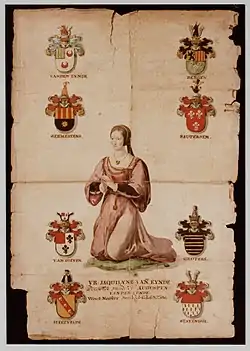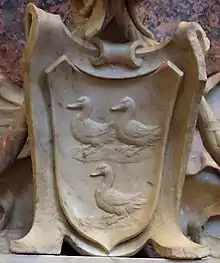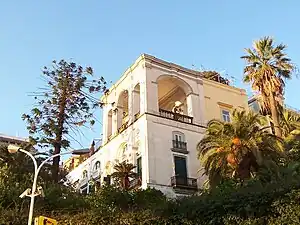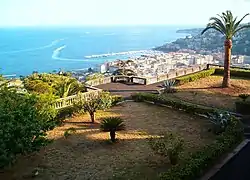Van den Eynde (family)
Van den Eynde is the name of an old Netherlandish noble family. One of the earliest recorded Van den Eynde to use the three-duck canting arms was Jacob van den Eynde, first Councilor and pensionary of Delft, and the highest[1][2] official in the county of Holland. The Van den Eynde became especially prominent in 16th-century Delft, 17th-century Antwerp (from whence the surname likely originates) and Naples.
| Van den Eynde | |
|---|---|
| noble family | |
 Coat of Arms | |
| Country | |
| Founded | 15th century |
| Titles | Marquess, Prince, Baron, Lord, Pensionary, Jonkheer, Castellan |
History

Surname
Eynde means end in Middle English.[3] Likewise, in modern Dutch, einde stands for end.[4] Van den is a very common prefix in Dutch language surnames, meaning "of the" or "from the." Although often assumed to derive "from the end," Van den Eynde likely stood for "of the duck" originally.[5] In Dutch,[6] duck is eend (Dutch: [ei̯nt] ⓘ). Eenden (ⓘ) is the Dutch plural form of eend. This is evinced in the Van den Eynde coat of arms, from which the surname might derive. Alternatively, the heraldic bearing might have been created to represent the bearer's name.
One of the earliest recorded Van den Eynde to use the three-duck coat of arms was Jacob van den Eynde, a statesman from Delft.[7][8][9] Jacob van den Eynde was first Councilor and pensionary of Delft.[10] In 1560 he became Grand Pensionary[11] of Holland. In 1568 he was accused of heresy and taken to Brussels, where he died in prison while awaiting trial.[1][10][12] Jacob van den Eynde was married to Elisabeth van Nieulant, from Bruges.[2][13] One of their several children, Egidius, was born in Puurs, Antwerp.[lower-alpha 1] Another of Van den Eynde's children, also named Jacob, was a Jonkheer,[12][16] and the castellan[16] of Woerden.[16] Jacob was the father of Jhr. Jacob van den Eynde (or Jacques van den Eynde;[2] or Jacobus Eyndius), the famous poet[2][17] and captain in Prince Maurice's army,[18][19] who settled in Zeeland.[2][17] He acquired the manor of Haamstede and rebuilt the Haamstede Castle, which had been a ruin since a fire devastated it in 1528.[20][21] Some Van den Eyndes had earlier achieved prominence in nearby Utrecht, where they became associated with the Tuyll. Jacoba van den Eynde married Jacob van Serooskerke. Jacoba (or Jacqueline)[22] was the daughter of Augustyn van den Eynde, of the House of Van den Eynde,[22] Opper Woutmeester of Brabant.[22] She and her husband resided at Zuylen Castle. In the late 15th and early 16th century, the Utrecht Van den Eynde used a different crest there.[8][23][24] In 1582, Emerentia van den Eynde, daughter of Karel van den Eynde, Treasurer-General of Oorlogen,[lower-alpha 2] married Willem van Beveren.[25]
Neapolitan branch
In the early 17th century, two Van den Eyndes from Antwerp, Ferdinand van den Eynde and his brother Jan, moved to Italy. Ferdinand, the elder, was a merchant and art dealer who settled in Rome, where he became part of the local Netherlandish community. He hoarded a valuable collection of paintings executed by some of the most prominent artists of the day, which he bequeathed to his brother Jan upon his untimely death in 1630. Ferdinand van den Eynde was buried in the church of Santa Maria dell'Anima in Rome. His sculptural epitaph was executed by François Duquesnoy.[26][27][28]
Jan van den Eynde established himself in Naples. He quickly enlarged his riches by trading in grain and gems. He later became a successful banker. In 1636 Jan van den Eynde became a business partner of Gaspar Roomer, and the co-owner of his firm. Roomer's company dealt in luxury goods, lace, silk, grain, diamonds and ship insurance. When Van den Eynde became Roomer's partner there was a substantial increase in the company's volume of business, particularly in brokering operations and silk trading.[29] Ferdinand and Jan van den Eynde traded goods between Antwerp and Southern Italy with ease, thanks to their connections in the Flemish city. They moved artworks between Antwerp and Italy as well, contributing to the spread of "new tastes and art movements" in Naples.[26][27] The Van den Eynde were related by blood[30][31] and by marriage[29] to several notable Netherlandish artists, including Brueghel, de Jode, Lucas and Cornelis de Wael, and the Gillemans.[26][27][28]

Jan van den Eynde later became one of the richest men in Naples, and a popular figure in the Southern Italian city.[26][27] He entertained the viceroys and developed strong ties with the Italian nobility. Van den Eynde acquired the Palazzo Zevallos Stigliano in 1653.[32][33][34][35] He restored the palace and filled it with a sizable collection of paintings. Van den Eynde was an avid art collector, and he put together one the largest collections of paintings in the napoletano. In the late 17th century Van den Eynde purchased a peerage title for his son Ferdinand. Thus, his son became the first Marquess of Castelnuovo. Van den Eynde married his two daughters (Giovanna and Caterina) to the heirs of two prominent local noble families (de Gennaro and Mastrilli). He imposed on his grandsons and heirs of the two noble houses to append his last name to their own, which they did.[36][37]
Ferdinand, 1st Marquess of Castelnuovo, further enlarged the collection of the Palazzo Zevallos, and built the sumptuous Palazzo Vandeneynden, today known as Villa Carafa, in Vomero. Ferdinand married Olimpia Piccolomini, of the House of Piccolomini, a niece of Cardinal Celio Piccolomini. He had three daughters by her: Catherine, Giovanna van den Eynde, Princess of Sonnino, and Elisabeth van den Eynde, Princess of Belvedere. Ferdinand died of consumption in 1674, the same year as his father Jan.[38][26][27][28]
His daughter Giovanna inherited the largest part of the Van den Eynde's fortune. She married Giuliano Colonna, member of the House of Colonna, one of the most notable Italian noble families. As a result of the marriage, Colonna acquired the Van den Eynde's riches. This allowed him to draw attention to himself and boost his position In Naples after his move there.[lower-alpha 3] Two years after his marriage to Van den Eynde, Colonna was selected by the King of Naples as ambassador to the pope for the traditional presentation of the chinea. In the following decades, the Colonna firmly established themselves in Naples. Van den Eynde's and Colonna's grandson Marcantonio went on to become viceroy of Sicily.[39][26][27]
Ferdinand's younger daughter, Princess Elisabeth, married Carlo Carafa, 3rd Prince of Belvedere, 6th Marquess of Anzi. The Carafa were at the time one of the most powerful Italian families together with the Colonna. Thanks to his marriage to Elisabeth, Carafa acquired the Palazzo Vandeneynden in Vomero, which thereafter became known as Villa Carafa of Belvedere.[26][27]
Antwerp Van den Eynde
In Antwerp, some people named Van den Eynde became prominent in the art world. However, their connection (if any) to the Van den Eynde described above remains unclear. None of them entered the peerage, and none of them is reported to have displayed a similar coat of arms.
Jan Van den Eynde II was a wealthy architect and entrepreneur. Although he was born into a wealthy family to begin with, he managed to augment his assets through his own business.[40]
In the late 17th century, the Van den Eynde became one of the most prominent families of sculptors in Antwerp.[40] They formed the informal Quellinus-Verbrugghen-Willemssens-Scheemaeckers-Van den Eynde consortium, which secured itself monopoly on the sculpture market in Antwerp.[40] Collaboration among the workshops of the aforesaid families in the late 17th century, might be the main factor to account for the intricate "unity of style and approaches that have made disentangling of hands particularly difficult for art historians."[40]
Among the Van de Eynde artists and art dealers who became prominent in Antwerp in the 17th century, there are:
- Cornelis van den Eynde (1586 – 1664), architect-entrepreneur, sculptor[40][41]
- Sebastiaen van den Eynde, sculptor, son of the above[40][41]
- Jan van den Eynde I (1592 – 1636), architect-entrepreneur, uncle of the above[40]
- Huibrecht van den Eynde, sculptor, brother of the above[40][41]
- Norbertus van den Eynde, sculptor, father-in-law of Jan Pauwel Gillemans the Younger and son of the above[40][41]
- Martinus van den Eynde[40]
- Franciscus van den Eynde, art dealer, poet, philosopher, teacher of Baruch Spinoza
Jan van den Eynde II was Cornelis' son.[40]
Several Van den Eynde rose to power throughout the early modern period in the region of Antwerp. In the late 18th century, Thomas Van den Eynde became a powerful pensionary of Mechelen and its province.[42][43][44]
Coat of arms
The coat of arms consists of three ducks argent on a field of blue (In blauw drie eendjes van zilver).[7][8][9]
Gallery
 Jacoba van den Eynde, ca. 1500
Jacoba van den Eynde, ca. 1500 Jacoba van den Eynde and Jacob van Serooskerke
Jacoba van den Eynde and Jacob van Serooskerke Cenotaph of Jeronimus van Serooskerke (1500-1571) and Eleonora Micault (1513-1552) in the Sint-Gertrudiskerk in Bergen op Zoom
Cenotaph of Jeronimus van Serooskerke (1500-1571) and Eleonora Micault (1513-1552) in the Sint-Gertrudiskerk in Bergen op Zoom Emerentia van den Eynde, consort of Willem van Beveren, Dordrecht, early 17th century
Emerentia van den Eynde, consort of Willem van Beveren, Dordrecht, early 17th century.jpg.webp) Jhr. Jacob van den Eynde, Lord of Haamstede, son of Jhr. Jacob van den Eynde
Jhr. Jacob van den Eynde, Lord of Haamstede, son of Jhr. Jacob van den Eynde Jacob van den Eynde
Jacob van den Eynde Jacob van den Eynde
Jacob van den Eynde Van den Eynde and Colonna coat of arms
Van den Eynde and Colonna coat of arms Van den Eynde coat of arms in Rome
Van den Eynde coat of arms in Rome Van den Eynde and Colonna coat of arms above the gate of Palazzo Zevallos in Naples
Van den Eynde and Colonna coat of arms above the gate of Palazzo Zevallos in Naples.JPG.webp) Palazzo Zevallos, interior court
Palazzo Zevallos, interior court Palazzo Zevallos, ceiling
Palazzo Zevallos, ceiling Palazzo Zevallos, pillars
Palazzo Zevallos, pillars Villa Carafa of Belvedere, once Palazzo Vandeneynden in Naples
Villa Carafa of Belvedere, once Palazzo Vandeneynden in Naples Terrace of Villa Carafa of Belvedere
Terrace of Villa Carafa of Belvedere
Notes
- Egidius decided to stay and live in his city of birth after its fall. Likewise, his descendants chose to stay in Antwerp, in the Spanish Netherlands.[14][15]
- (war)
- Giuliano Colonna was the founder of the Colonna branch in Naples[39]
References
- "Book of Hours, in Netherlandish - northern Netherlands (Delft), c.1460-80". Archived from the original on 24 September 2015. Retrieved 11 November 2020.
- Mémoires pour servir à l'histoire littéraire des dix-sept provinces des Pays-Bas, de la principauté de Liége, et de quelques contrées voisines Volume 9. De l'Imprimerie Academique via University of Michigan. 1767. p. 400.
- "ē̆nde, eende, eynde, inde, yende, yin(de". Middle English Dictionary. Retrieved 30 September 2020.
- "einde". Cambridge Dictionary. Retrieved 30 September 2020.
- Arie van den Ende. "Over de familienaam Van den Ende". zeeuwsevandenendes.nl. Retrieved 29 September 2020.
- "eend". Cambridge Dictionary. Retrieved 30 September 2020.
- "Historische Geslachtswapens". wazmar.org. Retrieved 29 September 2020.
- "Van den Eijnde". CBG Centrum voor familiegeschiedenis. Retrieved 12 December 2020.
- Naamen en Wapens der Edel en Agtbaare Heeren Veertig Raaden der stad Delft (1477-1772). CBG, GHS 50A22. p. 13.
{{cite book}}: CS1 maint: others (link) - Alexandre Henne; Alphonse Wauters (1845). Histoire de la ville de Bruxelles, vol. III. p. 384-385.
- Hendrik Willem Van Loon (1913). The Fall of the Dutch Republic. Houghton Mifflin Harcourt; University of Michigan. p. 409. ISBN 978-0-598-50292-6.
- Dirk Swart (1766). Korte levensbeschryving der Nederlandsche vorsten, helden en vermaarde mannen. geschikt naar de eeuwen waarin ze geleeft hebben. waarin voorkomen alle personagiën die in de Vereenigde Nederlanden eenig gebied gevoerd, eenige gedenkwaardige zaak ter uitvoer gebragt, te water en te land gediend, of zich ergens door vermaard of berucht gemaakt hebben; beginnende van voor de eerste eeuwe af, tot in de tegenwoordige eeuwe toe - Volume I. Netherlands National Library. p. 393.
- "Elisabeth Nieulant". Geni.com. Retrieved 28 November 2020.
- "Egidius Van den Eynde". Geni.com. Retrieved 28 November 2020.
- "Stamboom van de familie Van den Eijnde(n) uit Gemert en Haarlem". genealogieonline.nl. Retrieved 28 November 2020.
- Resolutien van Holland. via Ghent University. 1619. p. 1168.
- "De mythe van de 'Hollandse Graven'". ijpelaan.nl. Retrieved 28 November 2020.
- "Portrait of Jacob van den Eynde III (1575-1614), c. 1701". RKD. Retrieved 28 November 2020.
- "Portret van Jacob van den Eynde (1575-1614), ca. 1700-1720". RKD. Retrieved 28 November 2020.
- "Natuurgebied Slot Haamstede". natuurmonumenten.nl. Retrieved 28 November 2020.
- "Jacob Eyndius (Van den Eijnde)". encyclopedievanzeeland.nl. Retrieved 28 November 2020.
- Ferwerda, Abraham (Leeuwarden) (1772). Adelyk en aanzienelyk wapen-boek van de zeven provinciën; waar by gevoegt zyn een groot aantal genealogiën van voornaame adelyke en aanzienelyke familiën Volume 3. National library of the Netherlands via Abraham Ferwerda en Gerrit Tresling. p. 1.
- "Jacoba van den Eynde ( -1505)". RKD. Retrieved 30 September 2020.
- "Jacoba van den Eynde ( -1505), 16de eeuw". RKD. Retrieved 30 September 2020.
- Ferwerda, Abraham (Leeuwarden) (1772). Adelyk en aanzienelyk wapen-boek van de zeven provinciën; waar by gevoegt zyn een groot aantal genealogiën van voornaame adelyke en aanzienelyke familiën Volume 3. National library of the Netherlands via Abraham Ferwerda en Gerrit Tresling. p. 2–14.
- Ruotolo, Renato (1982). Mercanti-collezionisti fiamminghi a Napoli: Gaspare Roomer e i Vandeneynden. Massa Lubrense Napoli - Scarpati. pp. 5–55.
- Maria Grazia Lanzano. "6. Dai Coppola ai Lentini". Dizionario Dialettale di Gallicchio. Retrieved 1 June 2020.
- Lingo, Estelle Cecile (2007). François Duquesnoy and the Greek Ideal. New Haven, Connecticut: Yale University Press. p. 74-78; 198. ISBN 978-0-300-12483-5.
- Natalie Gozzano. "From Flanders to Italy: the Network of Flemish Dealers in Italy and the International Art Market in the Seventeenth Century". Accademia Nazionale di Danza, Rome: 174–180.
{{cite journal}}: Cite journal requires|journal=(help) - "Rubens, Van Dyck, Ribera: 36 capolari in mostra a Palazzo Zevallos". Il Mattino. 5 December 2018.
Stretti rapporti di parentela legavano la famiglia Vandeneynden a quelle di diversi artisti fiamminghi (i Brueghel, i de Wael, i de Jode)
- "Mediterranean Masterpieces - This Collection Tells the Story of Naples Through Its Art". Vice Media. 28 October 2019. Retrieved 22 August 2020.
- De Rose, Aurelio (2001). I palazzi di Napoli. Newton & Compton. ISBN 88-541-0122-2.
- Intesa San Paolo AA.VV. (2008). Gallerie di Palazzo Zevallos Stigliano. Intesa Sanpaolo.
- Arte'm AA.VV. (2014). Gallerie di Palazzo Zevallos Stigliano. Intesa Sanpaolo. ISBN 978-88-569-0432-1.
- Mazzoleni, Donatella (2007). I palazzi di Napoli. Arsenale Editrice. ISBN 978-88-7743-269-8.
- Gioacchino Maria De Stefano (1776). Per la signora d. Emilia di Gennaro principessa di Sirignano contra il signor d. Andrea di Gennaro marchese di Auletta. Commessario il regio consigliero signor d. Domenico Antonio d'Avena. Presso lo scrivano Rocco Sigismondo [Gioacchino Maria de Stefano]. Naples, Italy: Presso lo scrivano Rocco Sigismondo. p. 337.
- Gioacchino Maria De Stefano (1776). Per la signora d. Emilia di Gennaro principessa di Sirignano contra il signor d. Andrea di Gennaro marchese di Auletta. Commessario il regio consigliero signor d. Domenico Antonio d'Avena. Presso lo scrivano Rocco Sigismondo [Gioacchino Maria de Stefano]. Naples, Italy: Presso lo scrivano Rocco Sigismondo. pp. 30–341.
- Carmen Sanz Ayán; Bernardo José García García (2006). Banca, crédito y capital: la monarquía hispánica y los antiguos Países Bajos: 1505-1700. Madrid, Spain: Fundación Carlos de Amberes. p. 496. ISBN 978-84-87369-40-7.
- "Libro d'Oro della Nobiltà Mediterranea". Comitato Scientifico Scientifico Editoriale del Libro d'Oro della Nobiltà Mediterranea. Retrieved 1 June 2020.
- "Flemish sculpture: Art and manufacture c.1600-1750" (PDF). University College London: 19, 28, 33, 50, 66, 90, 93, 185, 192, 193, 196, 199, 205, 211, 251, 252, 258, 271. 2008.
- Lawrence, Cynthia (2003). "Eynde, van den family". Oxford Art Online. Oxford Art Online. doi:10.1093/gao/9781884446054.article.T027223. ISBN 978-1-884446-05-4. Retrieved 20 August 2020.
- Thomas ontmomd ofte brief van een Mechelschen Souveryn aen synen Medesouveryn Thomas Vanden Eynde, raekende syne justificatie uyt gestroeyd op den 5 julius 1790 ende de volgende dagen publickelyk verkogt. Brill. 1790.
- Pierre Auguste Florent Gérard (1842). F. Rapédius de Berg. Mémoires et documents pour servir à l'histoire de la révolution Brabançonne. tom. 1. The British Library. p. 300.
- Wekelycks Bericht Voor de Stad en de Provincie Van Mechelen Volume 6. Van der Elst. 1790. p. 160.
Sources
- Ruotolo, Renato (1982). Mercanti-collezionisti fiamminghi a Napoli: Gaspare Roomer e i Vandeneynden. Massa Lubrense Napoli - Scarpati. pp. 5–55.
- Stoesser, Alison (2018). Tra Rubens e van Dyck: i legami delle famiglie de Wael, Vandeneynden e Roomer. pp. 1–49.
- G.Porzio, G.J. van der Sman (2018). 'La quadreria Vandeneynden' 'La collezione di un principe'. A. Denunzio. pp. 1–76.
- Lawrence, Cynthia (2003). "Eynde, van den family". Oxford Art Online. Oxford Art Online. doi:10.1093/gao/9781884446054.article.T027223. ISBN 978-1-884446-05-4. Retrieved 20 August 2020.
- "Flemish sculpture: Art and manufacture c.1600-1750" (PDF). University College London: 19, 28, 33, 50, 66, 90, 93, 185, 192, 193, 196, 199, 205, 211, 251, 252, 258, 271. 2008.